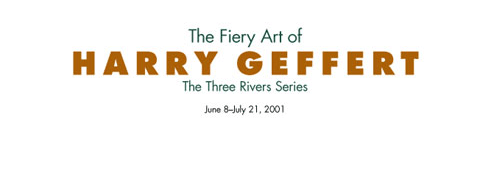


The Fiery Art of Harry Geffert: The Three Rivers Series
No artist has had a greater impact on his fellow artists than Harry Geffert, founder of the Green Mountain Foundry near Crowley, Texas, south of Fort Worth. A list of artists with whom he has collaborated in making sculpture in bronze over the past two decades reads like a Who's Who: Frances Bagley, Clyde Connell, Joseph Havel, Lucas Johnson, Linda Ridgway, and James Surls, plus Vernon Fisher and Virgil Grotfeldt. This, in addition to a quarter century in the art department of Texas Christian University, would ensure him a place in the pantheon of Texas artists. Nevertheless, Harry Geffert has never been satisfied as a mentor. His foremost ambition has been to achieve a deeper understanding of himself and the world around him through the art that he conceives and brings to life.
Dazzling in their technical proficiency—whether directly cast or employing the lost wax technique, smooth or rough in surface, richly patinated in color or more traditionally finished in deep greens or browns—his creations in bronze arrest the viewer. How did he do that? What gave him the ability to render in metal the most exquisite assortment of man-made and natural objects, from the smallest twig to the thinnest fabric? Due to his virtuosity, questions of this sort abound before the work of Geffert. And, admittedly, there is no more endearing quality to his work than his transformation of ephemera into art's most noble and challenging medium.
Virtuosity aside, his works impress as much by the layers of personal meaning they convey, their associations with his own experience of art and life and the plots and subplots introduced to make a complex narrative. Nothing is what it appears to be. To engage our attention, the elements are rendered in a most down-to-earth and concrete fashion. Yet they are then welded together in improbable or paradoxical relationships to address some universal theme like Original Sin or a more mundane, but no less pressing, issue such as overpopulation or the depletion of our natural resources. Recently, water and land are overriding themes, whether the growing shortage of water to nourish the soil and sustain life or the devastating effects of wind and seasonal changes to the forests. The massive wall reliefs entitled Black Water and White Water are metaphors for conservation. Similarly, the monumental group called Three Rivers, named for the small town south of San Antonio where he was born, explores the role of water in the ecological system, while Wind makes a poignant comment on the vulnerability of nature. Basic products that sustain life such as bread and crackers are also common symbols in his new work, and housing, with its attendant fencing, recurs on a regular basis to suggest the results of procreation and overpopulation. Many such symbols are cycled and recycled as independent works or as a means to enrich a narrative.
Harry Geffert's values, to be sure, are traditional. As a country boy who now occupies a thirteen-acre perch threatened by suburban sprawl, there is an air of melancholy in his meditations on life and its impact on the world we inhabit. For the first time Geffert has made photographs to accompany his narratives in bronze. These soft-focus images support the didactic theme of his sculptures while introducing another layer of reality, albeit for symbolic purposes. It is reassuring that an artist of Harry Geffert's talents and imagination has returned his full energies to making art, for his multifaceted and evolving art will long outlive his legacy as a peerless teacher and craftsman.
Edmund P. Pillsbury, Ph.D.

